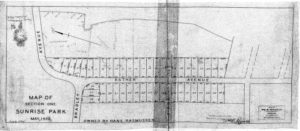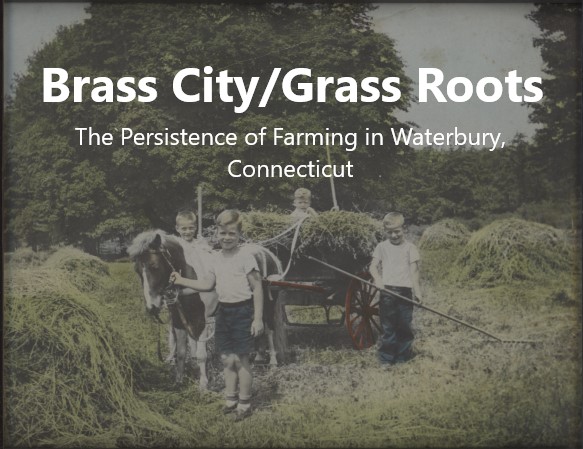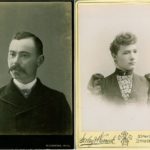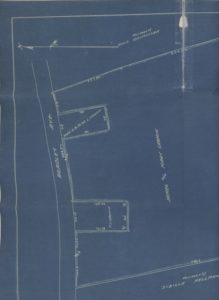This article is part of the digital exhibit Brass City/Grass Roots: The Persistence of Farming in Waterbury, Connecticut. Use the arrows at the bottom of the page to navigate to other parts of the exhibit.
- What used to be the Rasmussen farmhouse still stands at the corner of Bradley and Hans Avenues. Note the extended back area of the house where wood might have been stored or an unheated ‘summer kitchen’ might have stood. Hans is one of several streets in the area named after Rasmussen family members – Photo courtesy of Georgia Sheron, click to enlarge
- Portraits of Hans and Anna Rasmussen in their youth – Photo courtesy of Wesley Rasmussen, click to enlarge
- A pond on the extensive Rasmussen property provided swimming in summer and ice in winter. The ice was used to extend the life of the milk provided by the Rasmussen dairy herd so that it could be sold to customers in the center city neighborhoods of Waterbury. In 1926, the Rasmussens deeded three and a half acres of land surrounding this pond to the city to be made into a park. The park was never built – Photo courtesy of Wesley Rasmussen, click to enlarge
While many of Waterbury’s early Yankee agriculturalists often morphed from full-time farmers to manufacturers and “gentlemen farmers,” they were often replaced by the immigrants who toiled in their shops and bought their land. Some even argue that immigrants saved local farming in the 20th century.
Denmark-born Hans Rasmussen (1857-1930) arrived in Waterbury in 1882. Three years of industrial work later, Rasmussen and his brother-in-law had rented a dairy farm. In 1890, Hans married Anna, a Swiss woman whom he met on his milk route, and together they bought and shaped Malmalic Farm, which eventually contained 250 acres, a very large section of what is now the Town Plot neighborhood. The 18th-century house and barns were surrounded by apple orchards, chicken houses, and a large kitchen garden from which Anna derived the hearty meals she prepared daily.
By the 1910s, the Rasmussens had a large brood of mostly male children, 80 Holsteins, 150 to 200 hogs, and chickens, ducks, turkey, and geese. They carefully planted and grafted peach, pear, and cherry trees, replaced the barns, refitted the farmhouse with modern plumbing, and built stone walls between their fields and pastures, using the rocks that erupted from the earth every year. Every spring the family sugared the giant maples on the lane approaching the house.
The farm’s location in a wooded, hilly and swampy area provided a life that intertwined work and recreation. Water flowing down surrounding hills fed a pond for swimming in summer and ice in winter to keep the milk cold. The Rasmussen boys supplemented farm production by fishing, hunting, and gathering edible plants and nuts. The children had their own plots of land to cultivate potatoes and cabbages. These projects, along with the sale of Anna’s chickens and eggs, helped to supplement the income from the dairy farm and to provide a few luxuries like the piano in the parlor.
Every week, Hans drove a wagon laden with 40-quart milk cans over dirt roads that were little more than trails. He trudged up Waterbury’s tenement stairs to ladle milk from 8-quart “hand cans” into each household’s milk pail. At a time when farmers had to sell 22 quarts of milk to earn a dollar, it was hard work indeed. In summer and fall, the family loaded cabbages, potatoes, apples, turnips, and firewood on their wagon and sold them in town, as son Ernest remembered, “by display or by knocking on the doors of the Irish and Lithuanian folks.” [Ernest Rasmussen, “The Steward of Malmalic Farm” manuscript, ca. 1950s-60s]

When WWI made farm labor scarce, Hans Rasmussen began dividing much of his farmland into house parcels. Most of the houses did not actually get built until the 1940s, just in time for returning veterans and their families to move out of inner city apartment ‘blocks’ and triple deckers into single family homes in a more country-like setting. – Map courtesy of the Office of the Town Clerk, Waterbury, click to enlarge
When World War I erupted, labor was short, the boys were drafted, and the Rasmussens closed their dairying operation but quickly reinvented themselves. In 1919 Hans started a plumbing supply factory in his former dairy barns. The Rasmussen Manufacturing Company operated until 1925, when fire claimed the old wooden buildings. Hans became a developer, subdividing much of his land into half-acre parcels for house lots. The Depression and World War II stalled development, but Hans’ sons Floyd and Wesley continued their father’s project post-War, creating housing at a time when returning soldiers and immigrants “graduating” from the tenement districts clamored for single-family homes within a more “rural” atmosphere.
“[In 1894] four horses, fourteen cows of careless breeding, a couple of hogs, a few chickens and a miscellaneous assortment of old farm equipment, supplemented by a loving wife and two youngsters with a prospective third and fourth planned, comprised Papa’s early working assets.”
—Ernest Rasmussen, “The Steward of Malmalic Farm” manuscript, ca. 1950s-60s
The Cronins were another immigrant farm family in Town Plot, among a handful of Irish-surnamed people who could be found farming in Waterbury in the late 1800s and early 1900s. This blueprint portion shows how their property abutted Bradley Avenue and the Rasmussens. Much of their land is now part of the Holy Cross High School campus.
“The Depression came, my father was working the farm, and my uncle Timmy was working the farm, selling the milk. And they had a milk route, which covered part of Brooklyn, up here [Town Plot], Baldwin Street. People couldn’t pay for the milk and milk spoils, you’d end up giving it to them, probably never getting paid. But there wasn’t enough to keep two families going on the farm.”
—James Cronin
Note: ConnecticutHistory.org does not edit content originally published on another platform and therefore does not update any instances of outdated content or language.
<< Previous – Home – Next >>













